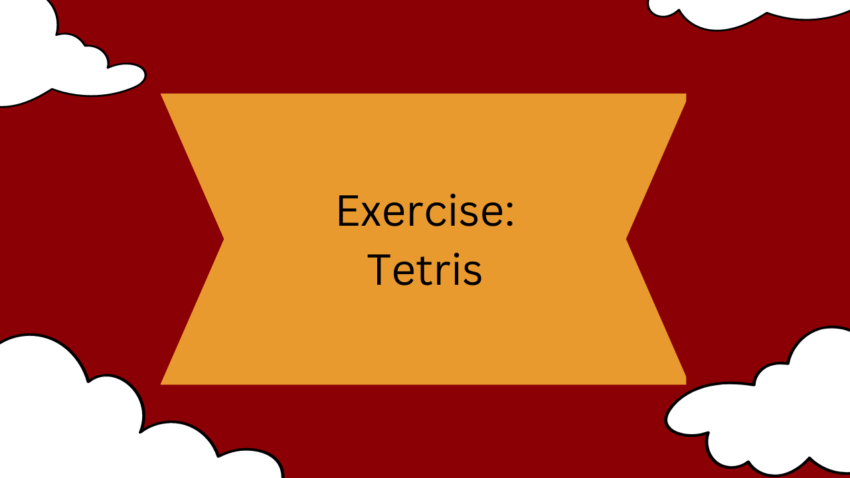Today, we’re looking at Tetris, and various reports that playing it can reduce symptoms related to memories, including PTSD and anxiety. We’ll talk about how this works, who it works for, and how to make this an effective tool in your arsenal.
The Exercise: Playing Tetris
Yes, you read that correctly. The exercise is simply playing Tetris when dealing with an unpleasant memory. Time reported in 2017 that Tetris had been used in clinical trials to reduce PTSD. The study they refer to is, in fact, only one of a number of studies done on different populations to measure the effects of playing Tetris on mental health symptoms. The idea is that when one has a flashback, intrusive thought, or distressing memory, they simply play Tetris for 15 minutes to reduce the long-term recurrence of that thought.
How Does Playing Tetris Improve Symptoms?
Playing Tetris in this way interferes with our memory reprocessing system. Basically, when we play Tetris while our brain is putting a memory away, it will put more energy into playing Tetris than into storing the memory. This interferes directly with the amount of data stored in the memory, and allows us to store different emotions with the memory, because playing Tetris feels, emotionally, very different from the chaotic or painful thoughts we are trying to disrupt. This would almost certainly work with other games, especially games which require complex thought. Tetris requires the player to evaluate shapes, track their progress, compete against a timer, and turn/place pieces while sometimes holding some in reserve or looking at the pieces coming up in the queue. Any game that has these (or similar) features is likely to serve a similar purpose.
My Experience
I have Tetris bookmarked on my browser, but I’ve never really enjoyed the game enough to play it a lot. Instead, what I have found is effective is playing a game like World of Warcraft where I can collect flowers and other materials out in the world, and have to worry about other players beating me to resources, or monsters interfering with me while I gather. I still get the visual, spatial, and time components, but it comes with beautiful environments and soothing music as well. This is a go-to option for me for managing my anxiety, and has served me well for many years.
It Works Like EMDR
Eye movement desensitization and reprocessing (EMDR) therapy is a therapy that uses visual and spatial components along with a licensed therapist to guide the person through the process of re-evaluating a memory and storing it away with better context or perspective. Using Tetris to interfere with the memory-making process uses some of the same principles, but lacks the licensed counselor to guide one through the process.
How Does Tetris Affect Memory
Memory is a very complicated system that is difficult to describe succinctly. But, I’ll describe the key components for this exercise. First, when we make a memory, it starts out fairly flexible. This is known as a “labile” memory. Your brain is still analyzing the information in the memory to determine which portions are important for us to retain for later use. When we experience a traumatic (or even just upsetting) event, our brains tend to pick them apart to collect as much information as possible to avoid any danger that might occur again in the future.
After several hours, or while sleeping, our brains pack this experience down into a long-term memory. This memory is kept alive in our brains until we need it again. When it’s needed, our brain copies it out for us to use, and the original memory dies.
Finally, once we are finished with our memory, we pack it up to make a new memory for later retrieval. This process can be very fast, for a memory, because our brain already knows that these parts are important, and it doesn’t have to analyze it again. It was previously assumed that “reinforcing a memory” meant making the original memory stronger, but in reality, it’s just adding more “important” information to the information our brain already thinks is important, so we store more overall information.
We can play Tetris at different stages of memory to have different overall effects on our memories. Let’s talk about how and when to use Tetris to improve your experiences.
Labile Memory Disruption
If we play Tetris while the memory is still labile, as in directly after the upsetting event, we can prevent our brain from allocating enough information to the memory to make a strongly traumatic memory. Whether that event is a car crash or other emergency, researchers have shown up to 62% reduction in intrusive memories if the person played Tetris, even before being seen by a doctor. The only key was that they were in a traumatic situation, asked to describe the worst details of it, then given Tetris to play. If we can reduce 62% of intrusive thoughts for everyone in every emergency, we’d have a lot less trauma running around, don’t you think?
Long-Term Memory Retrieval
Unfortunately, there may be less effectiveness if we try to play Tetris while recalling the event to discuss it. This is because we tend to not put enough energy into unpacking the memory to properly retrieve it. In fact, we may remember things incorrectly or our brain try to fill in the gaps, which are both counterproductive for our purposes.
Memory Reallocation
The most common form of disruption studied with Tetris is during memory reallocation, or the re-packing process of replacing a memory. To use this properly, we discuss or consider various details of the traumatic memory. Then, once we’ve unpacked that memory fully, we stop talking/thinking and start playing. This takes energy away from the re-packing process, and leaves us with a diminished version of that memory.
You Can Try
If you want to try using Tetris, try keeping a journal of your intrusive thoughts, and their severity before and after playing Tetris. Collecting data over time is the best way to know if this works for you, long term.
Caution
If you have a therapist or psychiatrist, it’s probably a good idea to discuss this with them before trying to amend your care plan. If you don’t have a care team, use caution, as always, when trying new things to manage your symptoms. I’m not a therapist, and neither is Tetris. Nothing can replace a licensed doctor or counselor. That said, there’s probably a low risk with trying Tetris since it’s a game, not a medication or invasive treatment method.
Thanks
Thanks for visiting. Starting next week, we’re diving into emotion skills, starting with emotional literacy, where you can learn about the 4 categories of emotions, how to recognize them in yourself and others, and how to change your own emotional responses. Remember to be kind to yourself and others.
Reference: Journal of Psychiatry and Neuroscience

